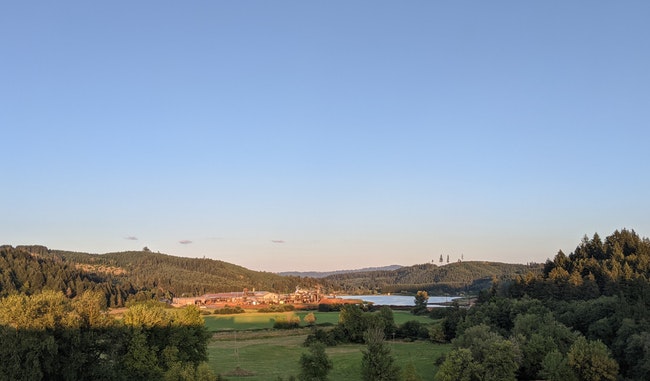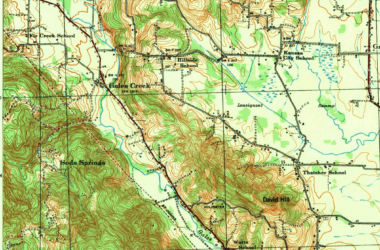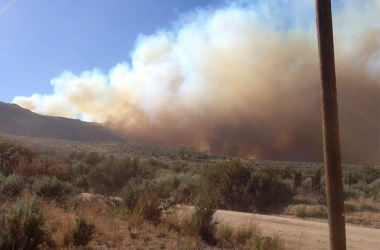 Stimson Lumber, as seen from the Scoggins Dam at Hagg Lake on August 3, 2020. Photo: Chas Hundley
Stimson Lumber, as seen from the Scoggins Dam at Hagg Lake on August 3, 2020. Photo: Chas Hundley
Have you ridden a bike down the same road you often drive? Have you then walked down that same road? If you do this, you will learn the same place can become a different place.
I thought about this today as I rode my bike to a farmer’s market in Forest Grove, Oregon. I got green topped carrots from a family farm, and a bunch of kale from another. Then I bought peaches from a farmer growing south of Mt Hood.
I thought about this because as a writer it seems like anything is possible on the internet. But I have found that possibility is very small. Possibility and probability eat away at one another. It seems a myth that the higher speed, the wider reach, really yield much.
[We rely on subscribers to keep the lights on at the Gales Creek Journal. Support us with a digital subscription: Click here to start]
I write this because just yesterday I was up at Hagg Lake which was a valley when my dad was a boy in this same valley. He grew up on a farm outside of Gaston, which first was a dairy and then moved to wheat. But when he was younger it was still a dairy and a place such as Hagg Lake didn’t exist — instead of the Stimson lumber company there were groves of oaks, and a wide stream which had steelhead and a salmon run. And a higher up valley, further into the mountains, there were wild rainbow trout (which are steelhead who have ceased to run the river).
I like the idea that steelhead become something gentler called a rainbow trout when they cease their oceangoing lives. Steelhead sometimes come back three or more times from the ocean to spawn. They are called steelhead because they are tough fish and their heads are the color of good steel.
But about the ride up to Hagg Lake I thought, I thought to myself as we walked through a field that I had last visited in 2016 to camp in, via bike, before a long bike trip through California — I thought to myself how different it was to shoot up there in a car and be up there in just a few minutes. And as I was walking amongst the grasses and flowers of the summer field there, I noticed bear poop in the grass that was filled with pits — and then I went down to the lakeshore, where people now drive loud boats and water ski above the deep flooded river where steelhead once swam — and found one plum that was almost pruned off the cliff itself by erosion — but it had two golden fruits.
I ate some of one fruit and gave part to my girlfriend Anna, and then as we walked back to the car I realized there were giant groves of plums all around, up the hill and between the grassy fields. The plum trees were loaded, heavy with fruit of two different types, and I was happy to see that a bear still lived nearby this dammed river valley, and relished the plums — indeed, life goes on.
When I got home that evening I read the Gales Creek Journal, which is a tiny newspaper out of a spot-in-the-road town of Gales Creek, which further up is the Tillamook burn and state forest that Gales Creek flows out of. And in the Journal there was a story, dating back to the 30s, a page from a diary of a woman who lived in Gales Creek —
“Fri July 10, 1931— Some cloudy. We ironed. Charley got a big rabbit up in the pasture about 8 o’clock. Gladie went up to Camp real early. Ted & Thelma came down after supper, the kids hoed potatoes again.”
– From the diary of Esther Lilly Hundley
The entries read like little poems. Each about one day. I guess she wrote them before bed, or maybe each morning about the last day. There is a lot of jam making and napping in the afternoon. These were not, I think, wealthy people. Yet they passed the time slowly, and didn’t have many wants. They had all their needs.
The journal itself reminds me of what walking can do — but a walking in the mind. Instead of hoping for my work to be something big, why not start somewhere closer? I think something we’ve left behind in these recent generations is a sense of caring for what is around us — just over the fence, rather than the horizon.
All I want to say is: you don’t often have to look far to find something worth saving. I think I wrote that down a while ago. It’s a thought worth rethinking, and doing too. Like a road well traveled, that can be traveled and traveled again in many different ways.
Hudson Gardner is a resident of Forest Grove, Oregon. A writer, Gardner’s work has appeared in American Public Media (On Being), The Sun Magazine, Taproot Magazine, and Patagonia. More work at grassjournal.co.






